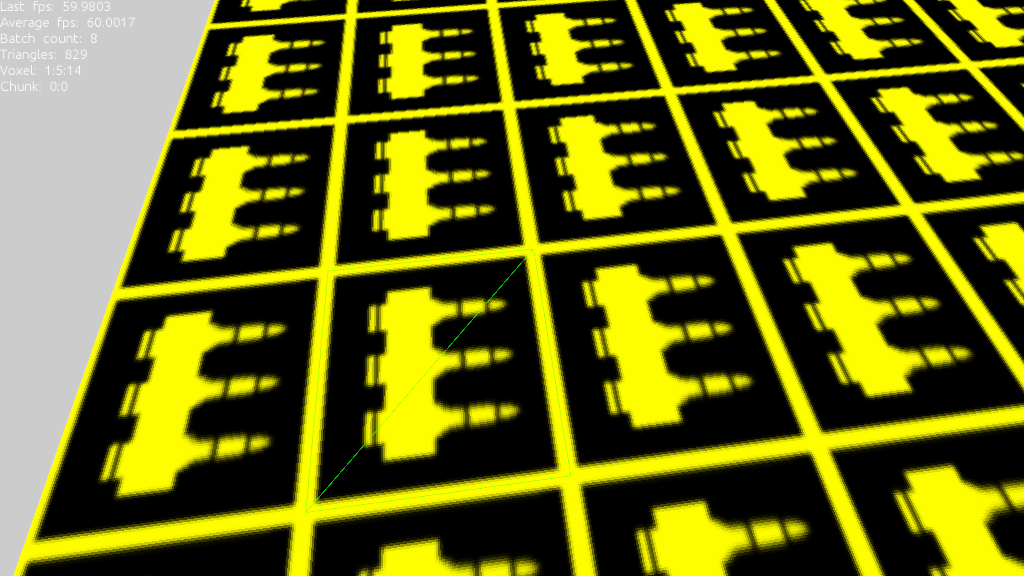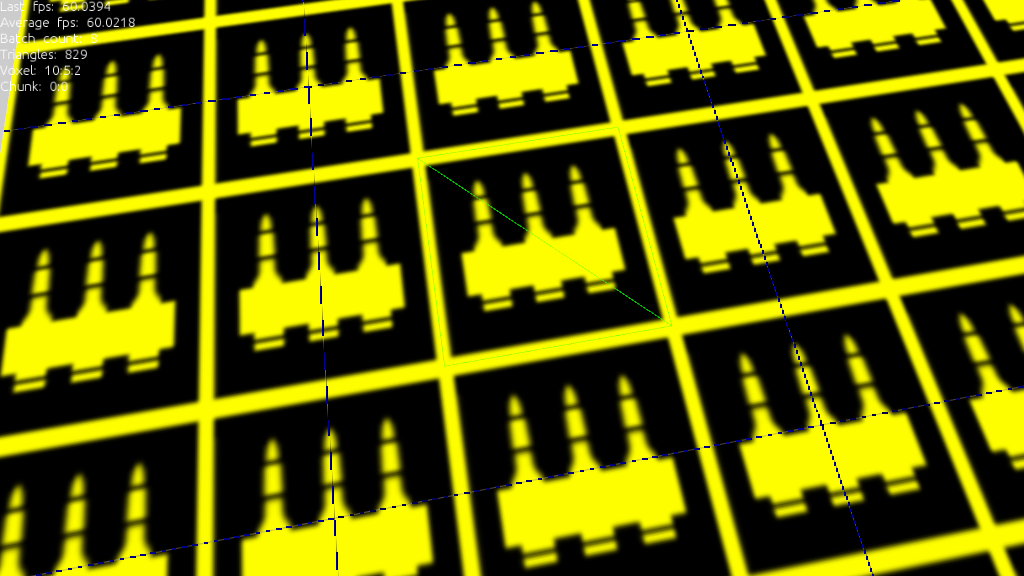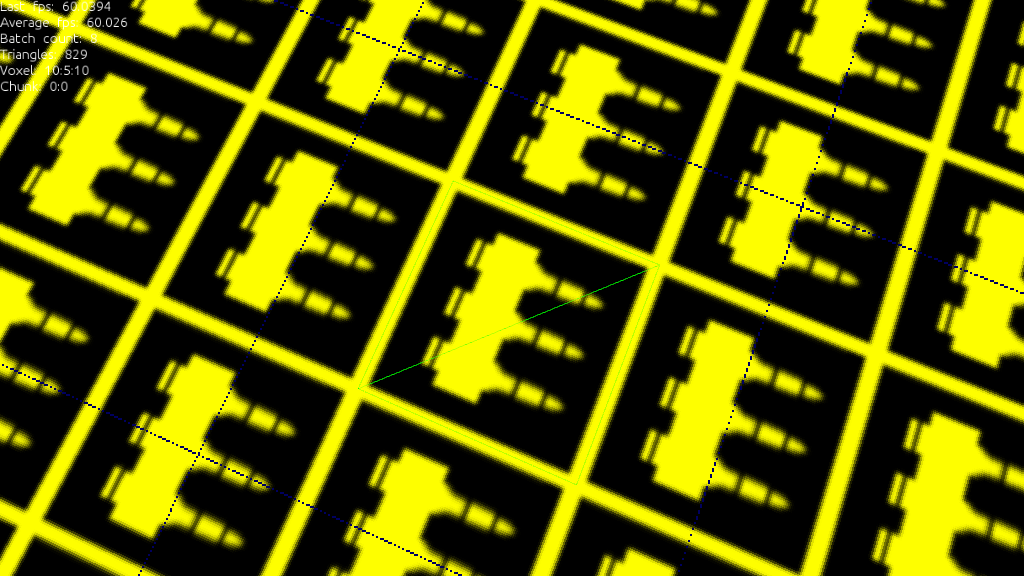Hi fellow developers!
I have an issue regarding texture atlases and "texture bleeding" using mipmaps and anisotropic (or linear) filtering.
I know that this is not directly related to PolyVox, but I thought that since there are a few people on this forum that are developing a "cube game" using PolyVox seemed acceptable.
By the way, why not creating a forum category for stuff like this ? Or more directly with integrating PolyVox with other libraries ?
So, I'm trying to put some textures on my Ogre3D cubes (generated from PolyVox) using an atlas.
I'm using the method described here : http://www.ogre3d.org/forums/viewtopic.php?f=4&t=61602
I read this topic also : viewtopic.php?f=2&t=77 (very interresting, and thanks to AndiNo for the texture, it's very useful for debugging)
When using point filtering and no mipmapping it works but it's not very beautiful...
Attachment:

point.png [ 127.16 KiB | Viewed 22379 times ]
When using linear filtering or mipmaps :
Attachment:

bilinear.png [ 221.91 KiB | Viewed 22379 times ]
Attachment:

mipmaps.png [ 167.19 KiB | Viewed 22379 times ]
Note : the light green zone represents one cube size.
Here is my material file :
Code:
vertex_program CubeVP cg
{
source Cube.cg
entry_point CubeVP
profiles vs_3_0 vs_2_x vs_2_0 vs_1_1 vp40 vp30 vp20 arbvp1
default_params
{
param_named_auto world world_matrix
param_named_auto viewProj viewproj_matrix
}
}
fragment_program CubeFP cg
{
source Cube.cg
entry_point CubeFP
profiles ps_3_x ps_3_0 ps_2_x ps_2_0 ps_1_4 ps_1_3 ps_1_2 ps_1_1 fp40 fp30 fp20 arbfp1
default_params
{
}
}
material Cube
{
technique
{
pass
{
// Vertex program reference
vertex_program_ref CubeVP
{
}
// Fragment program
fragment_program_ref CubeFP
{
}
texture_unit
{
texture atlas20.dds 2d
filtering linear linear point
max_anisotropy 1
tex_address_mode wrap
}
}
}
}
{
source Cube.cg
entry_point CubeVP
profiles vs_3_0 vs_2_x vs_2_0 vs_1_1 vp40 vp30 vp20 arbvp1
default_params
{
param_named_auto world world_matrix
param_named_auto viewProj viewproj_matrix
}
}
fragment_program CubeFP cg
{
source Cube.cg
entry_point CubeFP
profiles ps_3_x ps_3_0 ps_2_x ps_2_0 ps_1_4 ps_1_3 ps_1_2 ps_1_1 fp40 fp30 fp20 arbfp1
default_params
{
}
}
material Cube
{
technique
{
pass
{
// Vertex program reference
vertex_program_ref CubeVP
{
}
// Fragment program
fragment_program_ref CubeFP
{
}
texture_unit
{
texture atlas20.dds 2d
filtering linear linear point
max_anisotropy 1
tex_address_mode wrap
}
}
}
}
My shader file :
Code:
void CubeVP(
float4 inPosition : POSITION,
float4 inColor : COLOR,
out float4 outClipPosition : POSITION,
out float4 outWorldPosition : TEXCOORD0,
out float4 outColor : TEXCOORD1,
uniform float4x4 world,
uniform float4x4 viewProj)
{
//Compute the world space position
outWorldPosition = mul(world, inPosition);
//Compute the clip space position
outClipPosition = mul(viewProj, outWorldPosition);
//Copy the color
outColor = inColor;
}
void CubeFP(
float4 inPosition : POSITION,
float4 inWorldPosition : TEXCOORD0,
float4 inColor : TEXCOORD1,
uniform sampler2D texture : TEXUNIT0,
out float4 result : COLOR)
{
//Calculate the normals
float3 worldNormal = cross(ddy(inWorldPosition.xyz), ddx(inWorldPosition.xyz));
worldNormal = normalize(worldNormal);
float2 uv;
if(worldNormal.x > 0.5)
uv = inWorldPosition.yz;
if(worldNormal.x < -0.5)
uv = inWorldPosition.yz;
if(worldNormal.y > 0.5)//Down
uv = inWorldPosition.xz;
if(worldNormal.y < -0.5)//Up
uv = inWorldPosition.xz;
if(worldNormal.z > 0.5)
uv = inWorldPosition.xy;
if(worldNormal.z < -0.5)
uv = inWorldPosition.xy;
uv = frac(uv / 2 - 0.5);
uv = uv / 4;
result = tex2D(texture, uv);
}
float4 inPosition : POSITION,
float4 inColor : COLOR,
out float4 outClipPosition : POSITION,
out float4 outWorldPosition : TEXCOORD0,
out float4 outColor : TEXCOORD1,
uniform float4x4 world,
uniform float4x4 viewProj)
{
//Compute the world space position
outWorldPosition = mul(world, inPosition);
//Compute the clip space position
outClipPosition = mul(viewProj, outWorldPosition);
//Copy the color
outColor = inColor;
}
void CubeFP(
float4 inPosition : POSITION,
float4 inWorldPosition : TEXCOORD0,
float4 inColor : TEXCOORD1,
uniform sampler2D texture : TEXUNIT0,
out float4 result : COLOR)
{
//Calculate the normals
float3 worldNormal = cross(ddy(inWorldPosition.xyz), ddx(inWorldPosition.xyz));
worldNormal = normalize(worldNormal);
float2 uv;
if(worldNormal.x > 0.5)
uv = inWorldPosition.yz;
if(worldNormal.x < -0.5)
uv = inWorldPosition.yz;
if(worldNormal.y > 0.5)//Down
uv = inWorldPosition.xz;
if(worldNormal.y < -0.5)//Up
uv = inWorldPosition.xz;
if(worldNormal.z > 0.5)
uv = inWorldPosition.xy;
if(worldNormal.z < -0.5)
uv = inWorldPosition.xy;
uv = frac(uv / 2 - 0.5);
uv = uv / 4;
result = tex2D(texture, uv);
}
My atlas :
http://www.jmgr.info/atlas20.dds
So I'm trying to use only the "middle" of the texture and repeating it so that the "bleeding" disappears.
But there my knowledge of shaders is too limited so after several hours of fruitless efforts I'm asking you
Do you have any idea how I could achieve this ?